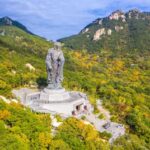Shan Juan Cave is located in the southwest of Yixing City, a renowned limestone cave that feels like entering a vast underground palace. Within the cave, one can witness the delicate and transparent stalactites as well as the grand natural boulders. There is also an underground river flowing through the cave. The scenic area includes several cultural sites related to the Liang Zhu culture, making it rich in content.
Limestone caves are a specialty of Yixing, with the three caves being Shan Juan Cave, Zhang Gong Cave, and Ling Gu Cave. Among them, Shan Juan Cave is representative and has been open to tourists since 1934, making it one of the earlier caves to offer tourism in China. Upon entering the scenic area, one will see the statue of Shan Juan, a poet from the time of Emperor Shun, who gained the name ‘Shan Juan Cave’ by secluding himself in this cave. Walking from the scenic area’s gate tower towards Shan Juan Cave, one passes through the Wild Valley, where ‘wild man performances’ are held at regular intervals, featuring actors dressed as wild men performing fire-spitting and hair-swinging dances. Sometimes, these performances are held when there are more tourists. Shan Juan Cave consists of upper, middle, lower, and water caves, each interconnected yet with different scenes. The water cave allows for boat tours, which is quite interesting. The middle cave serves as the entrance to Shan Juan Cave and is a naturally formed large stone hall, grand and magnificent. On both sides of the stone hall, there are huge stones resembling a green lion and a white elephant, vivid and majestic, hence the middle cave is also known as the ‘Lion Elephant Plaza’. The upper cave has peculiar stones standing on the walls, forming landscapes like ‘Lotus Reflection’, ‘Black Dragon Spraying Water’, and ‘Golden Rooster Standing Alone’. Inside the cave, there are also small streams converging into numerous pools and ponds, with ‘Nüwa Pond’ and ‘Pangu Pond’ being the most profound. Due to the constant cloud and mist within the cave, it is also called the ‘Cloud and Mist Plaza’. Scenes from movies like ‘Wisdom Captures the Tiger Mountain’ and ‘Journey to the West’ Episode 8’s ‘Yellow Wind Cave’ have been filmed here. The lower cave, also known as ‘Another Day’, has a narrow and elongated space with a waterfall cascading down from the cliffs, vigorous and passionate. The stalactites in the lower cave are different from those in the upper and middle caves; they resemble bananas or lotus roots, with various shapes. The lower cave also features landscapes such as ‘Heaven-Piercing Stone Pine’, ‘Nine-Tiered Pond’, ‘Old Longevity Star’, and ‘Cave Mansion’. The water cave is a 120-meter-long underground river, and by boating in the water cave, one can experience ‘the boat travels in the cave, the oar supports towards the sky’. Here, the water flows winding and deep, with colorful lights reflected on the water, creating a dazzling scene as if being in a crystal palace. In the Zhou Dynasty, there was a local legend of ‘the White Dragon Hidden in the Water Cave’, and during the Three Kingdoms period, King Sun Hao of Wu also enfeoffed and erected a stele for this. After disembarking from the boat and continuing on foot, one can reach the rear area of Shan Juan Cave, where the Liang Zhu Cultural Park is located. Here, you can enjoy a cup of tea brewed with purple sand pots, Yangxian Tang tribute tea, and mountain spring water, and then watch a Liang Zhu opera. There are also landscapes such as ‘Jin Zhu Ying Tai’s Tomb of the Qin Sword’ and ‘Zhu Ying Tai’s Reading Place’, where you can wear traditional costumes for photos.Embark on a scenic cable car ride to the mountains to admire the ‘Guoshan Stele’, erected by Sun Hao, the fourth monarch of the Wu Kingdom during the Three Kingdoms period. On the mountaintop, you will find the Yuantong Pavilion, housing fifty-three unique purple sand Guanyin hanging sculptures, a marvel of the world. Descend the mountain via a thrilling slide and visit the pottery studio to explore the purple sand collection exhibition. Here, you can create your own pottery using clay and take your creation home with you, albeit at an additional cost for framing.

The scenic area has limited dining options. However, ‘Luoyan Villa’, a hotel at the exit, offers meals and accommodation. Alternatively, you may return to the city for dining. For those driving, a visit to Zhangzhu Town, five kilometers southwest of the scenic area, provides a more convenient and economical option with local farmhouse cuisine.

Opening hours: 08:00-16:30 all year round.

Preferential policies: Children: Free for those under 6 years old (inclusive) or under 1.4 meters in height (inclusive), with valid identification or actual height. Half price for those aged between 6 and 18 years old (inclusive), with valid identification. Elderly: Free for those aged 70 years old and above (inclusive), with valid identification. Half price for those aged between 60 and 69 years old (inclusive), with valid identification. Students: Half price for full-time undergraduate and below students, with a student ID. Disabled: Free with a disability certificate. Active military personnel: Free with a military officer’s certificate.









